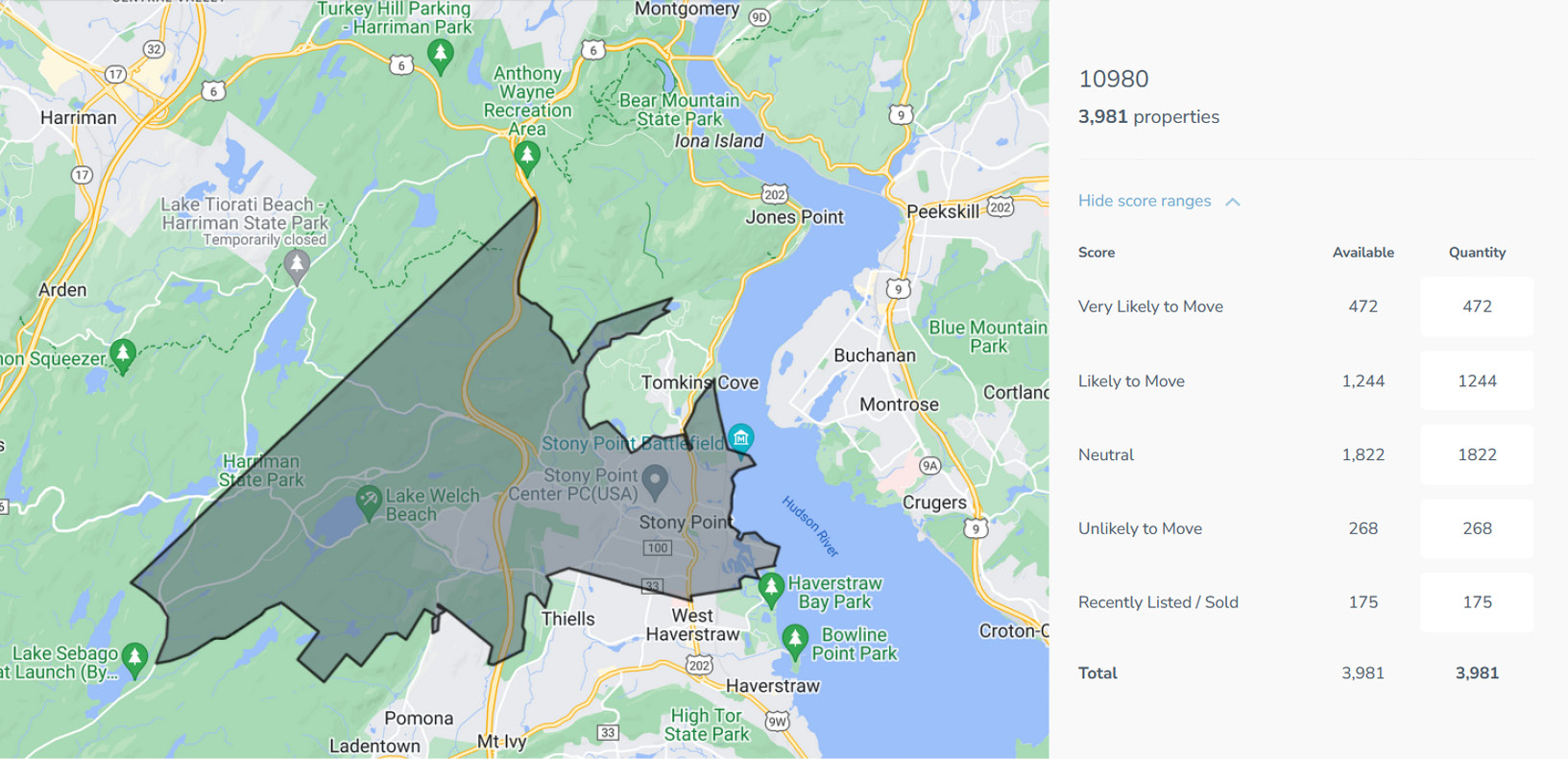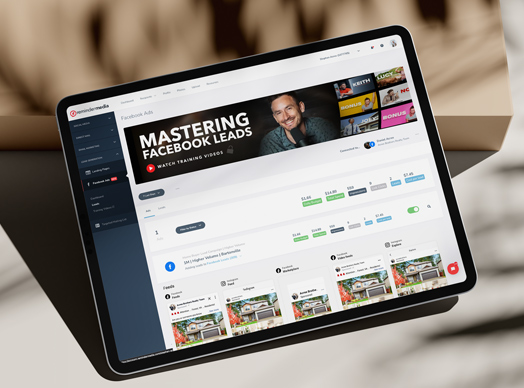In the perfect storm of 2024, what more can agents do to generate real estate seller leads?
When you’re in the thick of a market shift, trying to keep your real estate business from going under, platitudes like “Markets are always shifting” and “Just wait it out, it’ll be fine” are not helpful. Agents, and seller agents in particular, need practical strategies to help them find and sign new clients.
The year of high demand, rising rates, and shifting dynamics
While it is true that markets do ebb and flow, this year’s market is distinctly different from ones previously experienced. The challenge of buying and selling homes is significantly more difficult, causing many Realtors® to leave the profession; as such, it remains to be seen if the 10-year projected growth of 3% in the number of licensed agents comes to fruition.

The challenge of buying and selling homes in 2024 is significantly more difficult than what we’ve experienced in previous years.
The US housing market in 2024 is a perfect storm, created by a confluence of several factors:
- High demand, low inventory: Demand remains strong, especially from first-time homebuyers, but there are still too few houses available for sale. (Source)
- High mortgage rates: While they’ve come down a bit from late 2023, mortgage rates are still higher than in recent years, making home affordability a challenge. (Source)
- Slower but steady price increases: While there will be regional variations, experts predict a moderation in home price increases compared to the past few years. However, prices are still expected to rise slightly in 2024. (Source)
- An affordability crisis: Thanks to stricter lending standards and continued demand, a housing market crash is not anticipated. (Source) The bigger concern is affordability, especially among younger populations saddled with student loans and at the beginning of their careers. As of this year, it is now actually cheaper to rent than own in the United States’ 50 largest metro areas. (Source)
- A colossal change in the buying and selling process: The new rules begat by the NAR lawsuit and settlement have radically changed the process of buying and selling homes, leaving many perplexed by the consequences. (Source)
In short, the 2024 housing market is characterized by continued buyer demand, despite higher mortgage rates, competing with a limited supply of homes.
As you well know, interest rates are not something agents can control, nor can they control new housing starts. However, you can address the reluctance of homeowners to put their properties up for sale and work to find, or even create, motivated sellers. This blog offers several strategies you can use to generate lucrative seller leads.
But first, it’s essential that you appreciate what’s driving property owners’ hesitancy.
Understanding today’s home sellers

In spite of the high prices homeowners can likely get for their properties, many are simply not sure that this is the right time to sell.
Data from Zillow’s 2023 Consumer Housing Trends Report reveals that the typical US seller is around 45 years old, is likely married or in a partnership, and has some college education. Those in the South also appear to be most willing to sell, accounting for roughly 40% of home sellers. Furthermore, according to an April 2024 sellers survey conducted by Realtor.com, the four highest ranking reasons people are selling now are:
- To make a profit
- Family circumstances
- A need for more space
- A desire to downsize
Still, even the most motivated home sellers have justifiable concerns about entering the market.

Higher mortgage rates and worry that they may not find another home are keeping many would-be home sellers in place.
Mortgage rates
If they moved or refinanced their mortgages prior to the pandemic, current homeowners likely have an interest rate below 6%. In fact, U.S. News and World Report published an article in early April 2024 stating that 90% of outstanding mortgages are at a rate below 6%, with 65% of those being less than 4%. Given this reality, which many call the “golden handcuffs,” there’s little wonder why 79% of potential sellers feel they’re locked in to their homes because of their low interest rate. And who can blame them? In comparison to a 4% interest rate, today’s 7% to 8% is a hard pill to swallow even for those who are eager to sell.
As noted earlier, you can’t control interest rates, but you can emphasize to potential clients that rates are only one factor to consider when selling. Leverage the seller’s advantage in a competitive market and your personal track record of achieving strong selling prices, and you can better help them weigh the pros and cons.
Home inventory
Many interested sellers are also concerned about finding another home once they’ve sold their current residence. Despite numbers suggesting a hefty 21% year-over-year increase in home inventory, we still have a very real shortage of new home sales in this country. And even if a potential seller does find something to their liking, it may be priced above their budget because despite the equity released by the sale of their current home (which may be significant), higher interest rates diminish its buying power.

With higher than usual mortgage rates, the equity in a prospective sellers’ homes won’t buy as much as it used to.
To combat this significant concern, you’ll need to discuss strategies for navigating the competitive buying market as well as your successes helping clients find new homes in spite of the low inventory. You should also educate sellers on the various ways deals can be structured and what options might be available to them. (Here’s where having a trusted relationship with a lender comes in handy.)
Additional concerns
Mortgage rates and home inventory are only two of the more prominent issues on the minds of potential sellers. There will be others depending on their current circumstances that, while not unique to this market, may be exasperated by it.
First are a potential client’s goals for a new home.

Understanding what a prospect needs in a home will help you to best address their questions and lessen their apprehension about selling and buying now.
Knowing whether a prospect is looking for their dream home, a short-term solution, or a place to accommodate their family’s needs will enable you to best address their questions and lessen their apprehension about selling now. For example, if they are looking to stay in their new home for a significant period of time, you might encourage them to consider the long-term rewards of homeownership while discussing the opportunity to refinance in the future.
Then there are the emotional concerns about leaving a home an owner may be attached to.

Amidst all the factors affecting a homeowner’s reluctance to sell is the power of an owner’s potential emotional attachment to their current residence.
You need to acknowledge these feelings while framing the sale as an opportunity to achieve their aforementioned goals. And, of course, you want to assure them that you will offer your support and professional guidance throughout the selling (and potential buying) process.
How to get seller leads
So if you are in an area with a particularly low turnover rate, what can you do to find or otherwise generate real estate seller leads? Below are four proven strategies that will help.
1. Return to manual labor
Tom Ferry is known for saying that there is no such thing as a bad lead, so far be it from me to suggest you stop doing what you’re doing to generate leads—provided that what you’re doing is working. And how do you know if it is? You need to track and measure your activities. Then you can identify and double down on the ones that are producing income.
Stephen Acree, team lead at Acree Brothers Realty in Lynchburg, Virginia, believes that in this market agents need to engage in more active means of generating seller leads. His team has paused their content marketing and pulled back on other passive forms of lead generation to focus on what he calls “manual labor”—and it’s working. Since January, his team has closed 120 transactions.
“Agents need to be having more conversations,” he advises. “They’ve got to be in direct contact with homeowners. That means dialing the phones, knocking on doors, delivering educational seminars, and working with their referral partners. And with fewer transactions, agents must find ways to serve their sphere. It’s how they’ll stay relevant.”

In favor of active prospecting, real estate agents are well advised to have as many conversations as possible.
Of significant importance, Stephen says, is being able to explain to homeowners what’s happening in their local markets and why now may be the best time to sell. “If the turnover rate in your community is low, you can improve it by finding opportunities to explain to people just how much equity they have in their homes. You’d be surprised by how many have no idea what their houses may be worth. But they are always intrigued by what they might get for them, so it’s easy to generate interest.”
One tactic Stephen uses to create opportunities for conversations is sharing Zillow’s Zestimates with clients. He takes a screenshot of a client’s home estimate and sends it to them in a text message along with a short message: “Hey, [client’s name]. I just found this estimate for your home on Zillow. I have my thoughts on it. What do you think?” The majority of his texts get a response.
These and other conversations are great ways for agents to get appointments to look at homes and offer custom CMAs. “At the very least,” Stephen argues, “you’ve added another prospect to your drips.”
Finally, agents must have a firm understanding of the NAR settlement and its consequences. “Everyone is at least aware of what’s happened,” Stephen notes, “so expect people to ask you about it—and that’s a good thing. It’s a way to begin to engage with folks and demonstrate your expertise.”
2. Leverage technology and data
Perhaps one of the most valuable tools you can use to find home seller leads is predictive analytics, a type of AI that uses various sources of public data to forecast who is likely to move within the next 6 to 12 months.

Knowing who in an area is likely to sell their home is a game changer for agents needing to increase the efficiency and productivity of their lead-gen strategies.
When availing yourself of this tool, it’s wise to have realistic expectations. Predictive analytics isn’t perfect—its accuracy hinges on data quality, time frame, and the particular model’s ability to adapt to changing trends and personal situations. For instance, the model we use at ReminderMedia accurately identifies just 24% of homes in an area as “likely to move” or “very likely to move.” However, that percentage is nothing to blink at—it means that out of 300 predicted sales, we’ll correctly capture 72.
Even seemingly wrong results can be valuable, and sometimes digging deeper reveals hidden opportunities you might otherwise miss.
As an example, our company’s model flagged one of my coworkers as a potential seller, even though she wasn’t planning to relocate. As it turned out, her sister was house hunting, and my coworker was browsing Zillow and Redfin to help. Another client dismissed our report listing a young couple who just bought a home as “likely to move.” We urged her to follow up anyway. In that case, the couple was helping the wife’s parents downsize—leading to a new client for the agent!

When using predictive analytics, don’t hesitate to dig a little deeper if the data seems odd. You never know what you may find!
While any kind of predictive analytics will contain some false positives, targeting a set number of homeowners is still far more efficient and cost-effective than chasing every house in the area or guessing which will sell.
3. Use targeted online advertising campaigns
If you’re hoping to find warm seller leads using online ads, the key is to target them appropriately and offer a free item of value, also known as a lead magnet, designed to speak specifically to the needs and interests of sellers. Using the tools provided by Facebook, Instagram, and Google, you can select from a range of demographics and interests to define your target audiences. With this information, the respective platforms can help ensure that your ads are reaching your ideal clients.
We can help maximize your time and free you to have more conversations like those described above by running your Facebook ads for you. We have a team of experts who will assist you in setting up your ads account, then run our highest-performing campaigns for you. They’ll connect these campaigns to your ReminderMedia Lead Management Dashboard, which will send email and text notifications to let you know when new leads, including motivated home seller leads, come in. All you need to do is make your calls to follow up. You can click here to learn more.
4. Build trust and promote your credibility
In a low-inventory market, earning the trust of sellers who might be doubtful about listing their properties becomes paramount. There are several practical means to achieve this.
Become the local expert
A low-inventory market likely means more competition among agents for a smaller pool of sellers. To truly set yourself apart, you’ll need not only a firm understanding of the general real estate landscape but also expertise in the specific factors influencing a seller’s local area. This includes becoming familiar with trends in home values and buyer behavior unique to their neighborhood.
Use your in-depth knowledge of the vicinity and surrounding communities to explain with confidence what is influencing the market, and potential clients will feel assured that you have the strategic edge to help them achieve the best possible outcome for their property.
Serve rather than sell
In the current environment, it may be especially difficult for an agent to keep their need for a commission in check. But “commission breath” will only cause potential sellers to question your motives, which is why you need to curb your desire to sell and instead serve those in your sphere and the larger community. You can’t force a sale, but you can serve with intention and focus on widening your sphere—do that, and business will find you.

Serving your clients and community is a way for agents to stay relevant. (Click to get 25 free postcards plus a free landing page to capture leads.)
On our Stay Paid podcast, we’ve spoken with dozens of real estate agents. Interestingly, a common theme began to emerge in 2023—a surprisingly large number of them credited client and community events as a major factor in their lead generation. By serving their area in this way, they earn the gratitude of their communities and succeed in staying top of mind. Listen to this episode to get proven ideas for winning events, one for each month of the year.
Another way to be of service to your sphere is to connect them with people and businesses in their community. Ask conversational partners whether there is someone you can connect them with, such as a plumber or a contractor. Having a list of trusted referral partners is a way you can add value and garner referrals.
Use social proof
Trust badges and seals are forms of social proof you can add to your website and other marketing materials to boost your credibility and reassure visitors that yours is a legitimate business. Members of NAR can display their trust badge at no cost, while other companies, such as the Better Business Bureau and most security software companies like McAfee and Norton, require a fee.
If you are the proud recipient of an award or certification, be sure to add these seals to your website. You can also choose to show custom seals of your own making, like Calls Promptly Returned or 217 Satisfied Clients and Counting.
Client testimonials are another powerful instrument of social proof.
You’ve likely heard that a significant percentage of consumers read testimonials and reviews before making a purchase, with some sources reporting they are trusted as much as personal recommendations from friends and family. So start collecting testimonials and reviews from clients and publishing them where you can: on your website and social media platforms, in your newsletter and email signature, and in your listing presentations and materials. (Check out this blog for tips you can use to encourage more local reviews.)

Encourage and promote reviews and testimonials from satisfied clients to augment your credibility and enhance trust in your services.
Similar in purpose to testimonials and reviews are case studies. They are potent marketing tools because they speak to your expertise and skills, demonstrate your effectiveness, and—as you might expect—build trust.
Case studies can be many things, but they are generally stories that explain how a service provider, such as a real estate agent, solved a problem and achieved success for a client. In this market, a strong case study could be nearly any story about satisfying a client (reluctant or not) by getting them top dollar for their home and/or quickly finding them another home that’s perfectly suited to their needs.
“If opportunity doesn’t knock, build a door”
Attributed to comedian and actor Milton Berle, this quote essentially means you shouldn’t wait around for a great opportunity to land in your lap—sometimes you need to take the initiative to find it yourself. I believe it’s a fine message to use as a conclusion to this blog.
In this market, you can choose to keep doing business as usual and wait for things to get better, which they usually do. But you need to ask yourself whether you’ll still be in business when it happens. The best way to ensure that you are is to take the initiative to find and perhaps even create leads, helping people access the hidden equity in their homes and move on to their next chapter.
Yes, sellers are hesitant to let go of their cheaper mortgages and anxious about finding other homes. But by employing the four strategies discussed here—having conversations with people, leveraging technology and data, using online advertising campaigns to target specific audiences, and building trust by serving and demonstrating your expertise—you can increase your chances of success as a productive agent.































